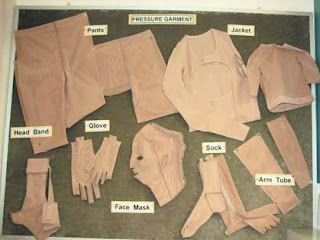TWO sewing machines rest side-by-side, their threaded needles poised in mid-air and ready for action. A neat rack of beige lycra rolls are at one end of the room while a whiteboard scribbled with deadlines is fixed on the opposite wall. Two seamstresses take centre stage. Bent over a green workbench, they diligently cut patterns from cloth bits, snipping sounds filling the otherwise silent room.
Welcome to the sewing unit at Singapore General Hospital’s Block 1 Rehab Centre, a modest but important place where pressure garments are made. Part of the Occupational Therapy Department, it falls under the Burns and Plastic Rehabilitation specialty and primarily serves patients of the SGH Burns Centre. Pressure treatment. During burns recovery, the skin may proliferate out of control to form rigid bumps called hypertrophic scars. To limit the formation of hypertrophic scars – which can hinder mobility when they grow over body joints – garments that exert pressure are worn, said Ms Anna Tan, Head of Occupational Therapy and Chief of Burns and Plastic Therapy Services at SGH. Generally, patients wear them for at least 23 hours daily over two years. “Each pressure garment is customized to the patient’s needs and the measurements go into his or her medical files,” said Ms Tan. “This is part of the medical treatment, although not the conventional type. When the scar stops growing, they will be flatter and softer from the pressure effect.”
Making a pressure garment come in various forms such as masks, gloves, arm tubes, pants and jackets. To make a pressure garment, measurements taken by the occupational therapist are given to the seamstress who calculates the reduction in garment size necessary for the pressure effect. The design of the garment is shaped primarily based on how the patient is burnt, but other considerations are also important. For instance, “we need to know if the patient will get help from family members in wearing the garments,” said Ms Tan. Comfort for the patient is important. To avoid irritating the skin, garments are made inside out with the seams on the outside, which also allows for easy grip and wearing. Velcro zips and elastic bands are added to keep the garments secure. For the severely burnt, garment designs require creativity like using double layers for better pressure, or pockets sewn for sturdy inserts like foam and putty-like elastomer at desired spots. The material used needs to give a snug fit without restricting movement, be able to stretch four ways instead of two for conventional fabrics and ‘breathe’ for comfort.
The SGH Burns Centre is the only burns centre in Singapore and it also serves the region. As such, we need to find a fabric in a colour that suits the majority,” said Ms Tan. “Not everyone will be happy with the colour but we have to find one which won’t look like a white patch on Indians or too dark on Caucasians.”Patients return monthly to check if their garments have loosened with daily wear, or became too tight because of weight gain. Generally, a pair of garments, used alternately, lasts about three months before brand new ones are needed.
Monday, April 20, 2009
Pressure control for burns recovery
Posted by Burn support group singapore at 1:35 AM
Subscribe to:
Post Comments (Atom)



0 comments:
Post a Comment